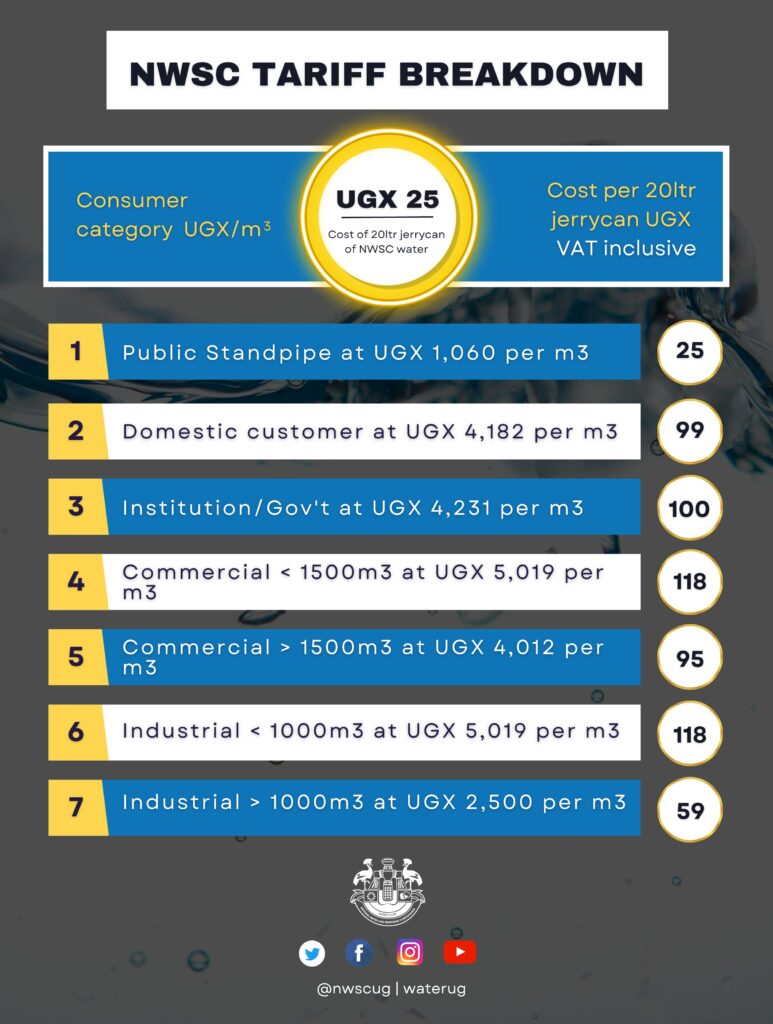
Water tariffs and pricing structures play a crucial role in maintaining the financial sustainability of the National Water and Sewerage Corporation (NWSC) while also ensuring affordability for consumers. To achieve this delicate balance, the Corporation must recover the costs associated with operating, maintaining, and investing in water infrastructure. These costs include expenses related to water treatment, distribution, infrastructure maintenance, and administration.
The water tariff is designed to strike a balance between cost recovery and affordability. NWSC is committed to establishing affordability benchmarks that guarantee water services remain accessible to all residents, regardless of their income levels. To achieve this, the Corporation provides consumers with clear and transparent information regarding tariff structures, billing methods, and any changes in rates. Effective communication is key in helping consumers understand their water bills and encouraging water conservation.
For consumers, understanding and selecting the right tariff is essential as it ensures accurate billing and effective management of water consumption. NWSC measures water usage through water meters installed at individual properties. These meters record the volume of water passing through them, and this data is used to determine consumers’ consumption for billing purposes. The cost of water is typically calculated based on the number of units consumed within a specified period, usually on a monthly basis.
Notably, there are different tariff structures depending on the type of consumer. The Public Stand Pipe tariff, for example, is commonly used in areas where public standpipes are provided as a water source for communities without direct household connections. This tariff is set at UGX1060 per m3, meaning that a 20-liter jerrycan costs UGX25.
The Domestic tariff is another commonly used structure, applicable to residential households with direct water connections. Under this tariff, the cost is UGX4,182 per m3, making a 20-liter jerrycan cost UGX99.
Institutions such as schools, hospitals, government offices, commercial buildings, and other non-residential establishments fall under the Institution tariff. This tariff is set at UGX4,231 per m3, meaning a 20-liter jerrycan costs UGX100.
For commercial and business establishments like apartments, supermarkets, malls, and arcades, the Commercial tariff is designed specifically. It’s important to note that this tariff also applies to construction sites. The cost under this tariff is UGX5,019 per m3, making a 20-liter jerrycan cost UGX118.
Regularly monitoring water meter readings or checking water bills is crucial in keeping track of consumption and identifying any potential leaks or unusual usage patterns. This proactive approach enables efficient water management and ensures accurate billing.
It’s essential to understand that the tariff structure and rates are based on your specific circumstances and consumption patterns. Taking the time to evaluate your options and comprehend the tariff structure empowers you to make an informed choice and efficiently manage your water usage.
By grasping the fundamentals, monitoring consumption, and making informed choices, individuals can effectively control their water expenses while contributing to the sustainable management of this precious resource.


